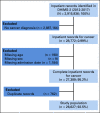Describing and Modeling the Burden of Hospitalization of Patients With Neoplasms in Ghana Using Routine Health Data for 2012-2017
- PMID: 36037414
- PMCID: PMC9470136
- DOI: 10.1200/GO.21.00416
Describing and Modeling the Burden of Hospitalization of Patients With Neoplasms in Ghana Using Routine Health Data for 2012-2017
Abstract
Purpose: The increasing cancer burden calls for reliable data on current and future associated hospitalizations to enable health care resource planning, especially in low- and middle-income countries. We provide nationwide estimates of the current and future burden of hospitalization because of neoplasms in Ghana.
Methods: We conducted secondary data (2012-2017) analysis using nationwide routine administrative inpatient health data from the Ghana Health Service. Multivariable Poisson regression was used to model spatial and temporal hospitalization trends stratified by sex and 5-year age group. In conjunction with official population projections, the model was used to predict future hospitalization up to 2032.
Results: Out of 2,915,936 hospitalization records extracted for 6 years, 26,627 (1.0%) were for neoplasms, most of them benign (D10-D36, 15,362; 57.7%) and in female patients (20,159; 76%). In total, 9,463 (35.5%) patients with malignancies were mostly female (5,307; 56.1%), had a median age 50 years (interquartile range, 34-66 years) and a median duration of stay of 4 days (interquartile range, 2-8 days). Poisson regression for the malignant cancers revealed an annual increase in hospitalizations with a relative rate of 1.23 (95% CI, 1.19 to 1.27). The estimated hospitalization rate for malignancies of female patients was 1.5 times higher than that of male patients (relative rate, 1.53; 95% CI, 1.00 to 2.34), adjusted for age. We predicted an increase of 67.5% malignant cancer hospitalizations from the empirical years (2012-2017) into the prediction years (2022-2032) in Ghana.
Conclusion: In the absence of a national population-based cancer registry, this nationwide study used secondary health services data on hospitalizations as a proxy for neoplasm morbidity burden. Our results can support planning public health resources and building evidence-based advocacy campaigns for neoplasm-prevention efforts.
Conflict of interest statement
The following represents disclosure information provided by authors of this manuscript. All relationships are considered compensated unless otherwise noted. Relationships are self-held unless noted. I = Immediate Family Member, Inst = My Institution. Relationships may not relate to the subject matter of this manuscript. For more information about ASCO's conflict of interest policy, please refer to
Open Payments is a public database containing information reported by companies about payments made to US-licensed physicians (
No potential conflicts of interest were reported.
Figures






References
-
- Benziger CP, Roth GA, Moran AE: The global burden of disease study and the preventable burden of NCD. Glob Heart 11:393-397, 2016 - PubMed
-
- Institute for Health Metrics and Evaluation (IHME) : Findings From the Global Burden of Disease Study 2017. Seattle, WA, IHME, The Lancet, 2018
-
- United Nations : General Assembly. Political Declaration of the High-Level Meeting of the General Assembly on the Prevention and Control of Non-communicable Diseases. Geneva, Switzerland, WHO, 2011, pp 13
-
- World Health Organization : Third United Nations high-level meeting on NCDs, 2018. https://www.who.int/ncds/governance/third-un-meeting/en2018
-
- World Health Organization : Global Health Observatory (GHO) data: NCD mortality and morbidity 2019. https://www.who.int/gho/ncd/mortality_morbidity/en/
Publication types
MeSH terms
LinkOut - more resources
Full Text Sources
Medical

